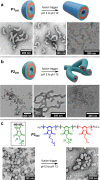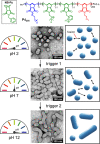Triggered Polymersome Fusion
- PMID: 36877655
- PMCID: PMC10021019
- DOI: 10.1021/jacs.2c13049
Triggered Polymersome Fusion
Abstract
The contents of biological cells are retained within compartments formed of phospholipid membranes. The movement of material within and between cells is often mediated by the fusion of phospholipid membranes, which allows mixing of contents or excretion of material into the surrounding environment. Biological membrane fusion is a highly regulated process that is catalyzed by proteins and often triggered by cellular signaling. In contrast, the controlled fusion of polymer-based membranes is largely unexplored, despite the potential application of this process in nanomedicine, smart materials, and reagent trafficking. Here, we demonstrate triggered polymersome fusion. Out-of-equilibrium polymersomes were formed by ring-opening metathesis polymerization-induced self-assembly and persist until a specific chemical signal (pH change) triggers their fusion. Characterization of polymersomes was performed by a variety of techniques, including dynamic light scattering, dry-state/cryogenic-transmission electron microscopy, and small-angle X-ray scattering (SAXS). The fusion process was followed by time-resolved SAXS analysis. Developing elementary methods of communication between polymersomes, such as fusion, will prove essential for emulating life-like behaviors in synthetic nanotechnology.
Conflict of interest statement
The authors declare no competing financial interest.
Figures





References
-
- Lu T.; Guo H. How the Membranes Fuse: From Spontaneous to Induced. Adv. Theory Simul. 2019, 2, 1900032.10.1002/adts.201900032. - DOI
Publication types
MeSH terms
Substances
LinkOut - more resources
Full Text Sources

